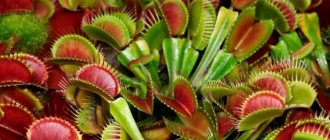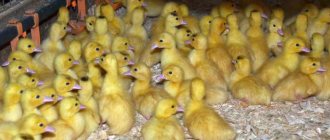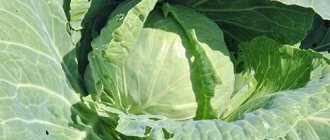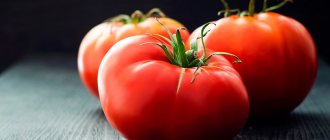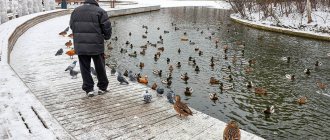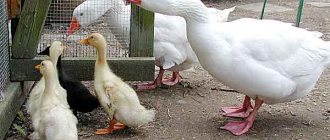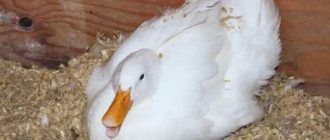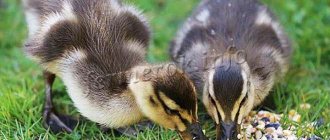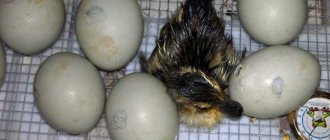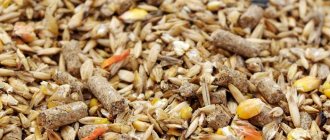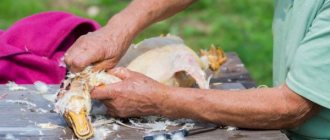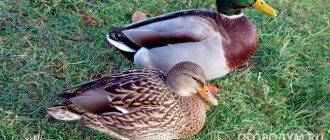Home » Articles about ducks » Cherry Valley ducks: description of the breed
Cherry Valley ducks are similar in genetic characteristics to the Peking breed. They are widespread in Russia. The birds' unpretentiousness to living conditions, strong immunity, and good meat and egg productivity contribute to their popularity.
Keeping at home
In order for Cherry Valleys to gain weight well and produce more eggs, they need to be provided with comfortable conditions.
There should not be more than three birds per square meter of poultry house
Table 2. Basic standards for keeping Cherry Valley ducks
| Index | Conditions of detention | Execution |
| Temperature | Not lower than 16°C | To prevent the mercury column in the poultry house from falling below acceptable levels, it is necessary to insulate the walls of the room. Install heaters on cold days. |
| Daylight hours | At least 14 hours | Ordinary light bulbs are suitable for additional lighting |
| Area standards | No more than three individuals per square meter | Equipped with spacious cages for convenient housing of livestock |
Cherry valleys are not very afraid of the cold due to their dense plumage and survive at above-zero temperatures. But these are heat-loving birds, and experience discomfort at low temperatures, which leads to inhibition of weight gain and loss of egg production. And if dampness is added to the coolness, there is a risk that Cherry Valleys may catch a cold.
Excess moisture also affects the plumage. It gets dirty and stops storing heat. Dirty birds try to clean their plumage and are constantly smeared with fat, which leads to irritation of the coccyx gland. The feathers around it fall out, exposing the skin, which increases heat transfer. This leads to decreased immunity and resistance to diseases.
Good ventilation will help disperse damp air, it will also reduce the amount of carbon dioxide and saturate the space with oxygen. But there should be no drafts. If it is intended to ventilate the poultry house using normal ventilation, the windows during its construction are mounted as high as possible.
Ducks should always have clean drinking water
Litter selection
To create comfortable conditions in the poultry house, you will need high-quality bedding. For ducks, the ideal deep version is: when one layer becomes dirty, a fresh one is sprinkled on it. This helps maintain the desired microclimate, since a biothermal process takes place inside the litter. Organic matter gradually breaks down and releases heat.
Proper bedding will ensure cleanliness, dryness and warmth.
The bedding material must be dry, hygroscopic, not moldy, and retain heat. These requirements are met:
- straw and chaff;
- sawdust and shavings;
- ground corn cobs,
- peat and dry leaves.
The litter is replaced twice a year - in spring and autumn. But adding layers must be done regularly. The duck house must be clean. A dirty room leads to the spread of infections. Used bedding material is sent to a compost pit.
Cherry wellies do not need perches. They are replaced by boards 40 cm wide and 50 cm long. They are fixed to the walls of the duck house 15 cm from the floor. Gaps are left between the beams for droppings to fall.
Bathing in water and ash
Ducks of this breed definitely need a place to walk with an equipped pond. It’s good if the site is located on the shore of a pond. But if there is no natural reservoir, an artificial pond is created. It should be so deep that the ducks can dive without any problems. In winter, water walking is stopped so that the bird does not catch a cold.
Cherry Valley needs a place to swim
Cherry valleys also like to swim in ash-sand “baths.” Such procedures relax the birds, help clean their feathers and prevent parasites. To arrange “baths”, wooden or plastic boxes are installed. They are usually made in the shape of a square, the sides of which are one and a half meters, and the height of the walls is 20 cm. The mixture of wood ash and sand in equal proportions needs to be changed once every 25 days.
In addition to a place for water treatments, the ducks are provided with a “bath” with sand and ash.
Poultry keeping
Rules taken into account when preparing a duckling house:
Choose a spacious room for keeping ducks. For 1 sq. m no more than 3 ducks are placed. Ducks should be provided with light for up to 12 hours. For additional lighting, simple medium-bright lamps are used. The light should be distributed evenly. The room temperature is kept at least +5 degrees
It is important to monitor the temperature especially on winter days. For laying ducks, the temperature should be increased. You should keep the duckling house in order, this will avoid the death of birds from unsanitary conditions. As bedding, you can use materials that absorb moisture and give off heat, such as peat, sawdust or straw. Provide good ventilation to prevent carbon dioxide from collecting in the house.
When arranging a poultry house for Cherry Valley ducks, standard perches are replaced with wide beams, which should be secured to the walls at a height of 20 cm from the floor.
Need to arrange housing
You should also provide ash baths for birds. They allow birds to clean their feathers of dirt and parasites. For a bath, a wooden box is suitable, the width of which is 1.5 m and the height is 20 cm. Ash and fine sand are poured into them. The contents must be changed at least once every 20 days.
You should organize a place for birds to walk. In spring and summer, a swimming pool for birds is built. In winter and autumn, you can limit yourself to a walk around the paddock with straw bedding.
Important! In winter and autumn, water treatments are contraindicated for these birds. Otherwise, colds may occur
This breed is not fussy about care. The poultry house should be cleaned regularly. Severe pollution will lead to the proliferation of diseases, which can destroy the entire livestock. Cherry Valleys have good immunity, so each poultry farmer decides on the issue of vaccination.
Feeders
When choosing a feeder, you should take into account that Cherry ducks scatter their food throughout the ducklings. Therefore, for the feeder you should choose a long trough with high sides. The containers are filled to a third. Ducks should always have clean drinking water.
Ducks should always have clean drinking water.
Nests
For nests, choose cardboard boxes or wooden boxes, which are placed along one of the walls. The dimensions of the boxes for one duck should be 60*50 cm, and the height - 10 - 25 cm. The number of nests is made twice as large as the number of birds.
Feeding adults
Poultry keepers often ask how and how much to feed Cherry Valley ducks
It is important to understand how to make a balanced diet for birds at home
Ducks are fed 2-3 times a day. There are 2 types of food:
- Dry food. It is most often used on industrial farms for automated feeders. It is granules of vitamins and vegetables.
- Combined feed. This diet includes morning feeding with wet mash. To prepare it, bran, herbal flour, fish waste, and cooked root vegetables are used. The mixture is diluted with water. You can also give whey or yogurt. The evening diet includes grains, oats or barley. To improve digestion, add gravel or chalk.
Feeding and caring for Cherry Valley ducklings
At seven months of age, birds begin to lay eggs. One individual can hatch up to 20 chicks. Ducks have a well-developed parental instinct, so they can sit on eggs on their own.
Important! When ducks sit on eggs, they should not be disturbed for the first couple of days. On the third day, in cases where the bird does not go to food, it is carefully removed from the nest and brought to the feeder
After the bird has eaten, it is returned to the nest.
Little ducklings have excellent immunity. The hatched chicks are covered with thick yellow down. The probability of death of young chicks, with proper care, is only 4%.
The nutrition of newborns should be selected in a balanced manner, with special attention paid to protein foods. For the first 10 days, babies should receive crushed eggs, cottage cheese, kefir
On the fifth day, you can introduce chopped herbs, onions or nettles into your diet. After the 11th day, the ducklings are given root vegetables and a little mash, which are intended for adults.
Blagovarskaya
Most poultry farmers prefer to breed birds not only to produce eggs and meat products, but also to decorate their farmstead. Blagovarian ducks are just such birds, valued for their tasty meat and external characteristics.
Description. The birds are large in size and have a horizontal, elongated body. A large head is located on a flexible, elongated, short neck. The physique is strong - in appearance the bird resembles a broiler. The voluminous, elongated body with a rounded, developed chest especially distinguishes the bird. The beak is a deep orange hue. The legs are short, widely spaced, with orange or pink paws. The birds have snow-white plumage.
Productivity. The weight of adult drakes reaches 4.4-5 kg, ducks - up to 3 kg. During the year, the laying hen produces about 200-250 large eggs weighing 90-95 g. The shell is white. The fertilization rate of eggs reaches 98%.
In winter, birds need a house to roost at night. The room is equipped with a heating and ventilation system, lighting, nests and feeders, drinking bowls, and windows.
Advantages. Rapid growth and weight gain. The birds have good meat performance and high productivity. The breed has increased resistance to various diseases.
Flaws. In order for birds to be healthy, grow quickly and gain weight, they need to be provided not only with good housing, but also with a balanced diet, which can be expensive.
Popular breeds of broiler ducks
There are many broiler breeds. Each hybrid has its pros and cons. Let's take a closer look at the most popular breeds so that you can decide for yourself which broiler ducks are best suited for breeding on your farm.
Peking duck
Peking duck is perhaps the most famous broiler duck breed. They are quite large; the weight of an adult drake can reach 3.5-4 kg. The color of the duck is white, less often cream. This breed is also distinguished by its egg production - ducks can lay up to 120 eggs per year. In order for ducks to gain weight well and build muscle mass, protein must be present in their diet.
Star 53
Star 53 is a meat breed of duck that was bred from the Peking duck in France. In appearance, Star 53 and Beijing are identical. The description of this breed states that this French bird is capable of gaining more weight in two months than an ordinary Peking bird. The weight of the drake should reach 4 kg after 60 days. But breeders claim that there is no significant difference between these two breeds.
Cherry Valley
Cherry Valley is also a cross of Peking duck, but of the egg-meat line, and has a high egg production (up to 150 eggs are laid per year). Such birds are slaughtered after 7 weeks. Their meat is red, tasty and tender. At two months, when they need to be slaughtered, drakes weigh 2.8-3.2 kg, and ducks 2.4-2.5 kg.
Mulards
Mulards - this breed was obtained by crossing a musky drake and a Peking duck. Mulards are distinguished by dietary meat, its fat content is no more than 20-23%. The meat is reddish, with a characteristic smell of turkey ducks. Mulards can be slaughtered a little later - after 4 months, but the weight can reach 6 kg.
Mulard ducks do not reproduce on their own. At home, even with an incubator, it is impossible to get offspring from them. Since ducklings are bred using artificial insemination, the price of young animals is quite high.
Blagovarskaya
Blagovarskaya is a breed bred in Bashkiria, distinguished by its bright white plumage and high egg production. These ducks grow quickly, weighing 3.2-3.5 kg at two months.
Agidel
Agidel - this hybrid appeared as a result of crossing ducks of the Super M and Blagovarskaya breeds, as well as the Indian runner. The main characteristic of this breed is increased egg production. Agidel ducks lay the most eggs among broiler ducks - from 210 to 230 per year.
Favorite
Favorite (another name is Blue Favorite or Blue Duck) is a breed of strong, stocky birds of the meat line. The name of this breed speaks for itself - these ducks have a remarkable gray-blue plumage. They quickly gain weight, by the end of the second month they weigh 3-3.5 kg, the meat is lean. Numerous reviews from breeders indicate that this duck is in demand.
Pace
Broiler ducks of the Temp breed were also bred not so long ago. Ducks gain weight well, at the age of two months they weigh up to 3.5 kg. The fat content of the meat is low, less than 20%.
When choosing ducks for breeding, take into account the color of the plumage - a white bird after plucking looks more attractive than a bird with dark or motley feathers. White duck carcasses have an even pink or yellowish color.
Breeding
Cherry Valleys begin laying eggs at 7 months. The egg weighs 70-90 g. In six months, with adequate nutrition, from 120 to 150 eggs are obtained from one individual.
For breeding, nests are installed indoors. One bird hatches up to 20 eggs. In the first 2 days, the duck is not disturbed. But if she continues to sit on the eggs, she is carefully transferred to the feeder and drinker. After she has eaten, the duck is returned to the nest, unless she herself has returned to the clutch. The procedure is repeated until the duck itself begins to leave the perch to feed and return to its place without outside help.
Growing Cherry Valley is not a troublesome task and is suitable for both production and household use. Following simple rules for raising ducks will help you make a good profit.
Bashkir
Breed of meat and egg orientation. Farmers of private farmsteads and industrial enterprises especially fell in love with these birds, due to the fact that they feed on almost any food and are able to independently satisfy their needs while walking in a meadow or on a pond.
Description. Ducks have protruding chests and a strong and muscular build. Large, widely spaced paws on short orange legs. The head is flattened on the upper side, located on a short, concave neck, curved outward. A concave orange beak with a wide growth that allows the birds to grab grass. The wings fit tightly to the body. The plumage is black-gray.
Productivity. Adult drakes weigh more than 4 kg, and ducks reach 3.7 kg. There is practically no fat in the carcass. The meat yield is at least 70%. One laying hen produces from 115 to 125 eggs weighing 70-80 g per year.
The bird is unpretentious in care, so it will feel good in special cages and pens. In the room for ducks, it is imperative to maintain an average temperature in winter, and set the optimal temperature in summer - it should not be hot.
Advantages. High survival rate of ducklings - about 80%. Birds also have increased resistance to infectious diseases, grow and develop quickly.
Flaws. Birds need to constantly drink clean water and change bedding, otherwise the animals may be susceptible to disease.
Diseases
According to the description of the breed, Cherry Valley ducks have good immunity to infectious diseases. Reviews from farmers indicate a high survival rate of young animals - 94-96%.
Problems can arise with an unbalanced diet. Vitamin deficiency leads to the development of vitamin deficiency. If the conditions of detention are violated and when walking in a natural reservoir, parasitic diseases are possible - it is recommended to carry out prevention. Simple folk recipes - installing ash baths, adding onion feathers and chopped pine needles to the food. After consultation with a veterinarian, medications can be used in prophylactic doses.
Description of the breed and productivity
Cherry Valley is a popular domestic duck that shares characteristics with Peking duck. Due to the high level of immunity in birds, the absence of the need to vaccinate and use medications for treatment, meat products are of high quality and have an increased vitamin composition. The meat of young individuals contains a minimal amount of fat and is considered red.
Cherry Valleys have both maternal and paternal cross lines. Crosses on the father's side are characterized by meat, and on the mother's side - by egg. The maximum weight of adult males is 4 kg, and females - 3.5 kg. Already at 7 months the weight of the young reaches 3 kg.
Resistance to diseases leads to maximum conservation of livestock. For adult birds, these figures reach 99%, and for ducklings – up to 96%. Ducks always have white feathers, and after molting they acquire a snow-white color. The bird's body has an elongated shape. A wide chest has a pronounced muscle structure and a layer of fat.
Low limbs of a rich orange color are located closer to the tail area. On a massive neck there is a small head. The forehead area is convex. The orange beak has a curved shape. The color range of the eyes is from blue to dark blue.
Diet of ducklings in the second and third decades of the first month
Gradually the diet is expanded by 10-20 g per day. Approximate diet for one duck chick:
- starting feed or ground grains 60-70 g;
- green and succulent food from 50 to 60 g;
- fish, meat broths, ground tripe 15 g. Add 0.3 g of salt to them;
- cottage cheese 10 g;
- boiled potatoes 40 g, you can add broth, meal, bran, cake in different proportions (up to 70 g);
- food additives: crushed shells and sand 3 g, bone meal, fish meal 1.5-2 g.
In the third decade of the first month, the diet is increased by 1/3, milk and cottage cheese are excluded. If Cherry Valley ducklings are grazing and swimming in a natural pond, then the diet can be reduced by 30%. After a month, the ducks are considered fully grown; their diet can only be increased slightly. This breed has a very short maturity period for slaughter. At 55 days, with a normal balanced diet, they reach a weight of up to 3 kg. There are two Cherry Valley crosses: maternal (less weight, egg-laying ducks) and paternal (higher weight, meat ducks).
It is worth noting that the Cherry Valley breed is quite heat-loving. In cold weather, the temperature in the poultry house should be kept within 16 C
The optimal daylight hours for ducks of this breed are 16 hours; in the evening it may be less intense.
It has three main requirements:
Breeding and further keeping of ducks also has its own characteristics.
| ||
| The Cherry Valley breed is very unpretentious in food and can eat any food. | ||
The daily diet should consist of the following components:
| From day 10, add a little to the diet root vegetables and mash are introduced. Crumbly wet mash, which is made with milk or water, consists of the following components:
| From the age of one month, ducklings are allowed to be released into a pond, where they additionally receive plant food, such as duckweed. But you need to remember that for rapid weight gain you need grain feed. The diet of an adult should contain:
|
Total information
Mulard ducks embody the best qualities of two breeds - musky and domestic ducks. They have almost no disadvantages, the only disadvantage is that they cannot have offspring. The reproductive instinct is also manifested in them, but the eggs are still unfertilized and are not suitable for breeding young animals.
The disadvantages of musk ducks include slow growth, low weight - in females it is less than 1 kg, heat-loving nature, late maturity - eggs are laid from the age of 6-7 months, and egg laying occurs in cycles - 5 months laying, 3 months rest. On average, the weight of duck eggs is 80-90 grams. Among the advantages of musk ducks are cleanliness, soundlessness, tasty meat, which has no fat.
Mulard ducks
Domestic ducks used for breeding mulards make too much noise, are unclean and prone to obesity. At the same time, they grow quickly and begin to lay eggs early, their live weight reaches 3.6 kg, and the incubation instinct is poorly developed.
Mulards were bred to correct the shortcomings of these duck breeds and enhance their positive qualities.
We watch a video with reviews from poultry farmers.
What can be said about the advantages of the Mulard breed? Poultry farmers give the most positive reviews. These are early maturing ducks, which at the age of 1.5-2 months gain live weight up to 1.5 kg, they are almost silent, clean, and have tasty meat. In three months, mulards increase their slaughter weight to about 4 kilograms, and the feed costs for them and Peking ducks are the same. The weight and size of females and males are almost the same. They are sometimes kept and fattened in cramped cages to produce fatty livers from which foie gras is produced.
The description of the Mulard duck is as follows: the body is oblong, the neck is of medium length, the head is small. Outwardly, such a duck is not much different from Peking ducks; perhaps its main difference is the white color of the feathers, black spots on the head, on the back and sometimes on the wings.
As we have already said, mulards do not reproduce, but they can be bred at home by crossing ducks of two breeds - Muscovy and Peking ducks. According to reviews from poultry farmers, in order to achieve the desired result, certain conditions must be met - mate ducks from mid-spring to early summer, the age of the bird should be within 7-10 months.
For mating, it is better to keep 5-6 ducks with one drake in a separate room or on a walking yard. The first eggs laid under such conditions will not be fertilized, but when the birds get used to each other, when the drake begins to cover the ducks, the eggs can be collected for the incubator.
According to experts, in some cases the black and white drake ignores ducks with feathers that are not the same color as his, so white ducks are brought into proper shape: their backs are painted with dark paint. After this, the drake begins to recognize them.
The collected eggs can be sent to an incubator or “entrusted” with hatching them to a hen if the farm has a duck with a pronounced maternal instinct. A brood hen is preferable for hatching eggs; with it, the hatchability of ducklings reaches 100%; if there is no brood hen, you have to use an incubator in which the hatchability will be 60%.
In the courtyard.
A nest for her is made in a quiet, cozy place in a cardboard box, basket or wooden box. Reviews from poultry farmers indicate that one brood duck can hatch 15-20 eggs at a time, but you need to make sure that there are enough feathers to cover all the eggs.
Read also: Viburnum foliage: planting and caring for shrubs in the garden
After 10 days of incubation, the eggs are checked with an ovoscope - unfertilized eggs without blood vessels are removed. Eggs with dead embryos that contain a blood ring are also thrown away.
During hatching, the duck gets up from the nest 1-2 times a day to eat, drink and bathe, so everything it needs should be near the nest. Bathing is necessary so that the wet feathers moisturize the eggs. Under favorable conditions, the ducklings will begin to hatch in 30-32 days.
After hatching, the hen takes care of the ducklings, and the owners’ task is to provide them with quality food. After 2-2.5 months, a Mularl duck can gain weight up to 3.5 kg, and by 3-4 months its weight will be 5-6 kg.
And in this video the mulards became participants in the exhibition.
Breeding the breed at home
The Cherry Valley duck is capable of laying eggs for hatching ducklings at the age of just over six months, when its ability to lay eggs has improved. Her maternal instinct is developed, so incubators will not be needed. Representatives of the maternal line are able to hatch 75% of the chicks, and the paternal line - 70%. 94-96% of young animals survive to one and a half months of age. The adult population is preserved up to 98%.
For the first two days, the duck sitting on the nest is not touched. If after this period she does not go to the feeder on her own, she is brought in while food is being served, then put back on the eggs. By repeating this action several times during the week, you can develop a reflex in the female. While waiting for the ducklings, the air temperature is maintained at least 14-16°C.
Maintaining a high level of livestock health ensures profitable breeding of the breed. Broiler duck is susceptible to vitamin deficiency, which negatively affects its well-being and provokes further complications. A lack of vitamin A causes eye disease, and a lack of vitamin E causes seizures and heart failure. Therefore, to maintain their level in the body, green mass, premixes and vitamin supplements are included in the diet.
Hypothermia and sudden temperature changes can lead to colds, runny nose, and omphalitis. Severe contamination of food and water causes intestinal infections. A weakened bird loses its appetite, becomes apathetic, and suffers from metabolic disorders. Therefore, careful care for the health of the duckling and the adult will ensure the preservation of the maximum number of livestock.
Planting Cherry Valley ducklings for adolescence
The most profitable ducks in the household
Cherry Valley, Cherry-velly
What should a barn be like?
In the warm season, Cherry Valley ducks can be kept either in a permanent poultry house or simply under a canopy - in an aviary. The first option is considered more preferable. If the ducklings are purchased, for example, in mid-late spring, under the canopy they will begin to freeze and get sick. In any case, the optimal ambient temperature for these ducks is 16-25 oC.
As already mentioned, for cherry valley it is advisable to equip a small pond on the site. You can simply dig a hole under the pond, cover its bottom with waterproofing material and fill it with water. Cherry Valley ducklings are allowed to be released to swim only after they have fledged. Bathing is contraindicated for small chicks raised without a brood hen. Such ducklings do not yet have subcutaneous fat. Therefore, in water they can easily become hypothermic. As a result, the kids will definitely get sick.
If it is not possible to arrange a pond, several large troughs with water should be placed in the Cherry Valley enclosure. It is not recommended to place such containers in a permanent poultry house. Cherry Valley cats love to splash around, and in this case the barn will always be damp. And this, in turn, can also cause the bird to become sick.
Mulards
Breeders created a hybrid in order to improve the qualities of the parent breeds to obtain a new, improved specimen. For crossing, indo-duck and domestic duck of the Peking white, Rouen, etc. breeds are used.
Description. The birds have a special appearance, making them difficult to confuse with other ducks. The sizes are large, the body is dense and elongated. On a strong, long neck there is an oval, small head. The body is supported on strong legs with short yellow-orange legs. The eyes are dark, the beak is flat, light yellow, and slightly elongated. The feathers fit tightly to the body. The feather color is predominantly white. The birds are calm, not noisy and clean.
Productivity. The hybrid has high productive qualities. In the first 2-3 months, ducks weigh 3.5-4 kg; at four months of age, body weight reaches about 6 kg. Duck meat is lean, especially valued in cooking and considered a delicacy.
It is permissible to keep ducks in an insulated shed where they will spend the night. Birds also need to be given free space to walk. The temperature in the poultry house should be no lower than +16 and no higher than +25 degrees.
Advantages. Calm disposition, precociousness, cleanliness, high meat performance, ease of care.
Flaws. Mulards are not found in the wild and are not able to reproduce on their own. Birds are raised exclusively at home.
A breeder of Mulardy ducks shares his experience of breeding them in the following video:
Biological features
Unfortunately, the plumage of these broiler ducks is not very thick. Cherry trees cannot tolerate Russian cold without reducing productivity. In the winter, the barn with these ducks must be heated. However, domestic summer residents breed cherry trees mainly only in the summer. After all, ducks are early ripening and reach slaughter weight by the age of 2-3 months. Therefore, in most cases, not very good resistance to cold does not play a special role when breeding this breed.
Currently, there are two main lines of cherry valley ducks bred on farms: paternal and maternal. In appearance, these two varieties are practically no different. However, their productivity indicators are not the same.
All Cherry Valley ducks love to swim. Therefore, their layer of subcutaneous fat is quite large. For the most successful keeping of these ducks on the farm, it is advisable to equip at least a small artificial pond.
In addition to excellent productivity indicators, farmers consider the good survival rate of young animals to be an advantage of cherry valley poultry. Lunging in a flock of these ducks is rare. The survival rate of Cherry Valley is 92-95% at an early age and 95-98% at the last stages of cultivation.
Characteristics of Cherry Valley ducks
The breed is distinguished by high quality characteristics, for which it is valued by farmers around the world.
- Individuals grow quite quickly. Birds at the 7th week of life already weigh about 2.5-3.5 kg. It is at this age that they are usually sent for slaughter. Carcass weight after slaughter – 66-68%.
- The poultry meat is red in color, a bit tough compared to white meat, but quite tender, with excellent taste. The meat is nutritious and contains many minerals and vitamins.
Carcass weight after slaughter – 66-68%
- The safety of adult birds is 98%, that of young birds is 95%.
- Females begin to lay eggs at 6-7 months of age.
- Females can produce 120-150 high-quality eggs per year.
- The weight of one egg is about 100 g.
Advantages and disadvantages
The characteristic of Cherry Valley is all-round productivity and gives breeders many advantages of keeping these ducks:
- fast growth;
- high income from the sale of meat and eggs;
- stable immunity of birds;
- good survival rate of ducklings and adult birds (98%);
- quick adaptation of ducks, unpretentiousness in everyday life;
- easy to care for, ideal for a novice poultry farmer;
- high profitability from the sale of young animals;
- variety of distribution channels;
- aesthetic and presentable appearance.
Cherry Wellies are kept in the same way as all domestic ducks. For breeding, it is enough to allocate the ducks an area for a poultry house, a small pond and a walking area.
The Cherry Welly breed has no particular disadvantages. The only downside to keeping it is the significant cost of feed. They do not skimp on their quality, since the speed of weight gain and the health of the birds depend on nutrition. The meat of such ducks has a characteristic game color and has a high fat content.
Characteristic diseases
If the house is dirty and the diet is inadequate, even persistent and hardy Cherry Velli will get sick.
What does a shortage of valuable elements in the poultry menu lead to:
- to conjunctivitis due to lack of vitamin A;
- to cramps and weak pulse with a lack of vitamin E;
- to Urovsky disease (or Kashin-Beck disease) with a deficiency of minerals.
The latter disease is manifested by ducks pulling out their own feathers, eating sawdust and swallowing small pebbles.
To normalize the condition of your pets, you need to adjust the diet by adding the missing elements. Vitamin deficiency is compensated by the abundance of greens in the diet and premixes. Deficiency of mineral elements - by adding meat and bone meal to the feed.
Premixes for farm animals and birds
In cold and damp poultry houses, ducks get cold, do not want to move, and lose their appetite. The consequences of this can be diseases such as omphalitis and catarrh. If an infection has penetrated through the feed or dirt in the house, the ducks will have intestinal upset.
If symptoms of the disease appear, the sick bird should be placed in a separate cage, and the poultry house should be disinfected. Then a veterinarian is called to examine the sick duck, make the correct diagnosis and prescribe treatment.
Use of feed
Growing cherry wellies only on mixed feed significantly reduces the labor costs of creating a menu and preparing food for ducks. Combined feeds contain a full range of substances in the proportions necessary for the health of the bird.
This method is used by all large poultry farms, rationing and supplying feed using a mechanized method. For private owners and small farms, the main difficulty is to choose a high-quality, inexpensive composition so that profitability does not suffer and the ducks get everything they need.
Useful tips
Ducklings should not be given:
- bread;
- dairy products (except cottage cheese);
- flour;
- boiled porridge (except oatmeal);
- berries (strawberries, raspberries, any others);
- grape;
- silage;
- fresh nettle (it must be dried or doused with boiling water);
- onion;
- cabbage;
- sunflower seeds;
- chicken feed;
- maple leaves (causes intestinal blockage and death of chicks).
You can feed corn, peas, legumes, oats, cake, meal, wheat, rye, barley, tomatoes, carrots, grass, and give mineral supplements (chalk, shell rock, bone meal, coarse sand, crushed shells). Vegetables must be chopped and it is best to fill them with water. The bird also loves aquatic vegetation, insects and worms. Small fish can be given only after the ducklings have swum in open water.
Diet planning
Cherry trees grow quickly; to gain weight, you need to choose a balanced diet. The fast metabolism of ducks ensures the digestion of different types of feed. The simplest type of feeding is when kept on a water run, which is often practiced in households. Cherry valleys happily eat grass, algae, small aquatic inhabitants, insects and receive a full set of vitamins, micro- and macroelements. But this method of content is not available to everyone. Most poultry farmers are forced to create their own diet and select a menu for ducks. There are 2 feeding methods:
- Dry – consists of mixed feed, grain, granulated mixtures. This diet is practiced by large farms, where feeding is automated; the mixture is poured according to the norm into a mechanical feeder.
- Combined – using a varied set of feeds. Typically used in households.
In small farmsteads it is advisable to use a mixed type of feeding. Feed composition and basic rules:
- Ducks need to be fed 2-3 times a day.
- Succulent food consists of forbs - dandelion, nettle, meadow species. They give cabbage leaves, chopped carrots, pumpkin, zucchini. To strengthen the muscular system, add boiled potatoes. The grass is crushed, dried, and steamed.
- Grain mixtures – crushed wheat, oats, barley, millet. In summer, legumes are introduced into the diet.
- Boiled porridge, leftovers from the table.
- Cake is given to increase the calorie content of feed.
- Protein components – different types of bone meal, waste meat, fish.
In the morning, Cherry Valleys receive roughage (hay), grass, and mixed vegetables. When walking, juicy components do not need to be used. Ducks need roughage to start digestion and stimulate intestinal motility. For evening feeding, a mixture of grains is given. In cold weather, the diet is supplemented with protein feed to prevent the ducks from freezing.
Feeding rules
The health and productivity of poultry depends on proper nutrition. Diet also affects the taste of meat. In nature, ducks feed on greens, insects, and plankton. At home, they need to choose a diet that will replenish all the necessary nutrients.
In large farms, Cherry Valley is given as feed. On average, one duck needs 260–300 grams of food per day. They pour food into the feeders three times a day - morning, afternoon and evening.
Standards for issuing feed to ducks
Owners of private farmsteads usually feed ducks with self-created food. For breakfast and lunch, wet mash is suitable, including swollen grains (corn is best) and bran, herbal flour, boiled potatoes or carrots, table scraps and some dairy products. For dinner, the bird receives oat and barley sprouts, dry grains, and a little crushed shell or chalk. “Dishes” need to be lightly salted.
To make the meat tastier, you should add greens and cabbage leaves to the food. During the period of active egg laying, the amount of mineral supplements is increased to improve the properties of the shell.
Babies of this breed grow rapidly. They need a lot of protein. For the first seven days after hatching, they are fed chopped eggs and cottage cheese. You can add chopped young nettle after scalding the leaves. When the ducklings are one and a half weeks old, add other greens - clover, dandelion leaves and crumpled boiled potatoes. Then gradually add a little mash at a time so that the kids adapt to adult food.
When the ducklings are three weeks old, they are given four meals a day.
The babies are fed six times a day. By the age of three weeks, the number of meals is gradually reduced to four, and after another week the young animals are transferred to the adult diet. With a full diet, by seven weeks young birds gain 2.6–3.5 kg of live weight.
Birds of this breed eat sloppily; it is important to keep the feeders and the area around them clean. To maintain hygiene, the easiest way is to install elongated trays with high sides and fill them no more than a third
The water in the drinking bowls is changed after each feeding.
What to feed cherry tomatoes?
For homesteaders, cherry ducks are convenient because they independently regulate the amount of feed. Feeders are filled with certain foods; individuals will eat as much as they need for normal existence. They do not reduce productivity. Raising livestock is simplified. Birds eat succulent food, grain mixtures, and roughage. Females are recommended to be given food in the form of wet mash.
Cabbage leaves, meadow grass, willow leaves, dandelions, and nettles are used as succulent food. The herb is crushed and pre-steamed to make it softer. Along with grass, they give zucchini, watermelon, pumpkin, and carrots. To increase weight and normal muscle function, cherry tomatoes are fed with boiled potatoes. Cake, bone meal, and yeast are added to food. A mandatory component of the diet is chalk or crushed shells. Along with the grain, gravel and a little table salt are poured into the mixture.
The grain mixture is prepared from barley, wheat, millet and corn, which forms the base. In the summer, peas and soybeans are added to the mixture. Legumes stimulate egg laying. In winter, legumes are not recommended to be included in the diet. The duck’s body must rest and recover before the productive period.
Grain mixtures with protein supplements are given to ducks during evening feeding. In summer, the livestock eats less of it than in winter. Protein feed replenishes the body with energy, which the bird spends on warming its body in the house, on the normal functioning of all vital systems, and on laying eggs, if egg production does not stop.
Housekeepers often discuss the English breed on forums. Reviews are different. Many people like it for its unpretentiousness and good productivity. Some householders note the fatty meat of the poultry, but the good quality of the eggs. Cherry Valley ducks occupy a leading position in poultry farming.
Broiler duck breeds
There are several subspecies or breeds of broiler ducks; which one to grow should be decided by the farmer himself. Among the total number of breeds, the most popular ones should be highlighted.
Mulard
Mulard
This breed came to Russia from France. Birds are distinguished by dietary meat, with a low fat ratio. They grow quickly and are unpretentious in maintenance. For good growth, ordinary pasture will be enough for them. The only thing that upsets me is that the chicks need to be bred artificially, or rather by crossing a musk drake with a Pekin duck. In this case, Mulard will inherit a large amount of muscle from his father, and rapid growth from his mother.
Cherry Valley
These birds are very popular on farms because they gain weight of more than three kilograms already in the third month of life. Upon reaching maturity, a duck is capable of laying more than one hundred and fifty eggs throughout the year.
Blagovarsky
Individuals of this breed gain weight up to four kilograms already in the eighth week of life. During this entire period, the young animals eat at least three kilograms of well-prepared food. The meat tastes very tender.
Medeo
A bird can gain more than two kilograms of weight, provided that it is properly cared for. In addition, it is highly productive. In a year, one hen produces at least one hundred and fifty eggs.
Medeo
Agidel
The most unpretentious, but at the same time the most productive breed of broiler ducks. She is able to grow with poor maintenance, despite this, the laying hen will produce about two hundred and forty eggs throughout the year. In six months, the bird grows by three kilograms in weight.
Pekingese breed
Peking broiler duck remains the most popular in Russia. It is this that is the basis for developing new breeds of broilers.
Birds of this breed are slightly smaller than other varieties, but, nevertheless, the female weighs about three and a half kilograms, the male grows by four kilograms. Over the course of a month, the young gain more than two and a half kilograms.
If you like the Peking broiler duck, a description of the breed will help you understand what is needed to raise it. Birds of this breed are distinguished by their large heads and beaks, painted in a bright orange color. Their body is wide, both from the back and from the chest. The neck is strong, strong, but not too long. The wings are strong and fit tightly. The legs are set wide apart and are orange in color. The plumage of the birds is pure white.
Pekingese breed
The peculiarities of the Peking duck are its high metabolism, which occurs due to its body temperature.
Important! The bird's body temperature must be constantly maintained, thanks to this it will produce good growth. Thanks to the short intestines, birds digest food quickly. For this reason, they constantly need food.
Only in this case will they gain weight and remain healthy.
For this reason, they constantly need food. Only in this case will they gain weight and remain healthy.
Thanks to the short intestines, birds digest food quickly. For this reason, they constantly need food. Only in this case will they gain weight and remain healthy.
Caring for little ducklings
Unfortunately, not all farmers have the opportunity to buy Cherry Valley chicks, despite the fact that the cross is quite popular. After all, not every poultry farm sells just such ducklings. However, if desired, a farmer can order a hatching egg from a bird of this breed without any problems. Ducklings are hatched using standard technology.
The hatched chicks, after their down has dried, are “relocated” from the incubator to a brooder or box. Initially, the ambient temperature for ducklings is maintained at a level of at least 30 ° C. Then, within a week or two, this figure is reduced to 24-26 °C.
Cherry Valley ducks – a successful cross
Any owner will be happy to keep in his house a breed of duck that is characterized by high egg production, rapid weight gain and unpretentious maintenance. Cherry Valley ducks fully meet the above requirements. They can be classified as birds of combined productivity. You can successfully obtain both meat and eggs from these ducks.
Story
Cherry Valley ducks originated in England. Birds of the Peking duck selection were taken as the basis. Characteristics of the paternal line (151):
- egg production – 120 eggs;
- weight of young animals at seven weeks is 3.4 kg;
- weight of adults: females – 3.5 kg, males – 4 kg.
Characteristics of the maternal line (102):
- egg production – 150 eggs;
- weight of young animals at seven weeks is 2.9 kg;
- weight of adults: females - 3.4 kg, males - 3.7 kg.
This two-line cross combines the best qualities of both lines. It has gained popularity among poultry farmers in many countries around the world. The breed came to the post-Soviet space in 1972. She has not lost her popularity even today. It is purchased with pleasure both for private farmsteads and for large poultry farms.
Cherry Valley ducks look very similar to Peking ducks. They have a powerful build and a vertical body posture. The wings are short, tightly pressed to the body, short legs, thick neck. Bright orange beak and white plumage (in the vast majority).
Cherry Valley ducks: characteristics
This is perhaps one of the most popular and fastest-ripening meat breeds. Ducklings gain weight up to 3 kg in two months. Meat yield averages 65%. The slaughter yield reaches 80%.
Despite the fact that this breed of Cherry Valley ducks has a meat type of productivity, it inherited high egg production from the maternal line - up to 150 eggs in seven months. Ducks begin laying eggs at 6 months. They are perfect for those poultry farmers who want to raise poultry themselves.
The Cherry Valley duck (you can see the photo in the text) does not require special conditions. The bird is unpretentious and pays very well for food. For summer keeping of birds, a spacious barn with bedding for overnight stays (the main thing is that there are no drafts), free grazing during the day and access to water is sufficient.
In winter, you will need an insulated room, the ideal temperature for keeping it is +10...+14 °C (in any case, not lower than +6 °C). As the degrees drop, the bird stops laying eggs and suddenly loses weight. To maintain the level of weight gain and maintain good egg production, the birds are given longer daylight hours using artificial lighting. Its total duration should not be less than 10-12 hours.
Ducklings are very hardy, the survival rate is high. The most important thing is to control their feeding for the first couple of days so that all the babies peck at the food together. A properly selected diet from the first days of a bird’s life will help to achieve the desired result.
Ducks are fed both plant and animal food. The diet includes crumbly mash; they are prepared in milk or water. Season with hard-boiled eggs and millet porridge. Gradually introduce grains and herbs. Greens that are useful for ducklings include dill, onions, clover, dandelions, and sow thistle. At the age of a month, the young animals are released into the pond (if there is one).
We must not forget that well-selected and balanced food will help ducklings gain the necessary live weight on time.
Advantages
The Cherry Valley duck breed is distinguished by a number of qualities that distinguish it from the variety of other duck breeds:
- intensive growth of ducklings (by 2 months, young animals gain 80% of the weight of an adult);
- high egg productivity - up to 150 eggs;
- safety of young animals 96%;
- safety of adults 98%;
- unpretentious to the conditions of detention.
Today, in private and small farms, there is a clear trend towards breeding poultry that can gain weight in 45-50 days. Cherry Valley meets these requirements, and this is precisely the secret of such a demand for the breed.
The level of demand is influenced by the fact that many specialized farms are engaged in their breeding. Private owners and farmers always have reliable suppliers of quality cherry valley duck stock.
History of appearance
Ducks first appeared in England at a breeding company of the same name “Cherry Valley”. The genetic material of Peking ducks was taken as the basis for selection.
Ducks came to our country in the seventies of the last century. Large poultry farms were the first to develop Cherry Valley breeding. Over time, private entrepreneurs and small farmers took up this business. The ease of caring for ducks and the high productivity of the breed have made it possible even for private individuals to breed these birds right in their suburban areas.
The description of the Cherry Valley breed is practically no different from the Peking ancestor, the features of which are revealed in the article “About Peking ducks.” As for meat and egg productivity, according to these indicators, ducks are not inferior to their close relatives.
